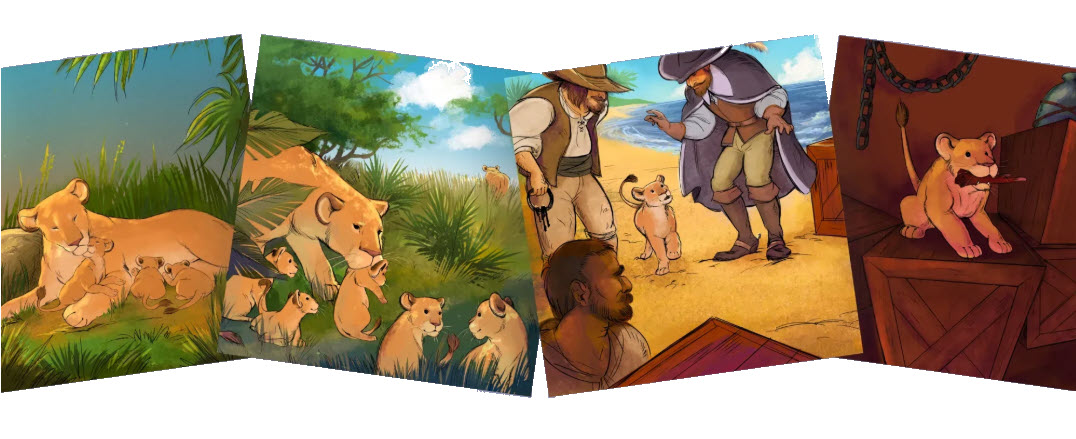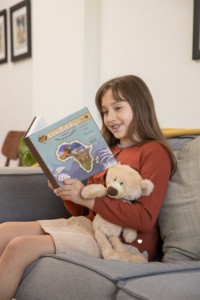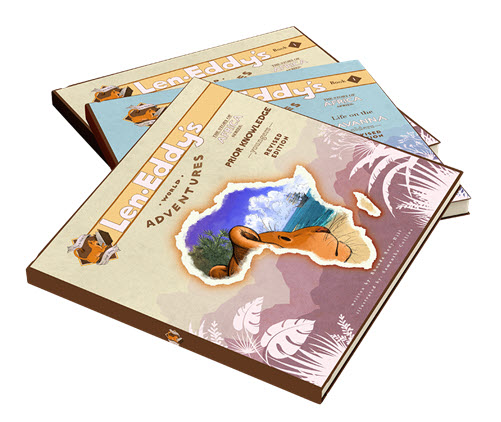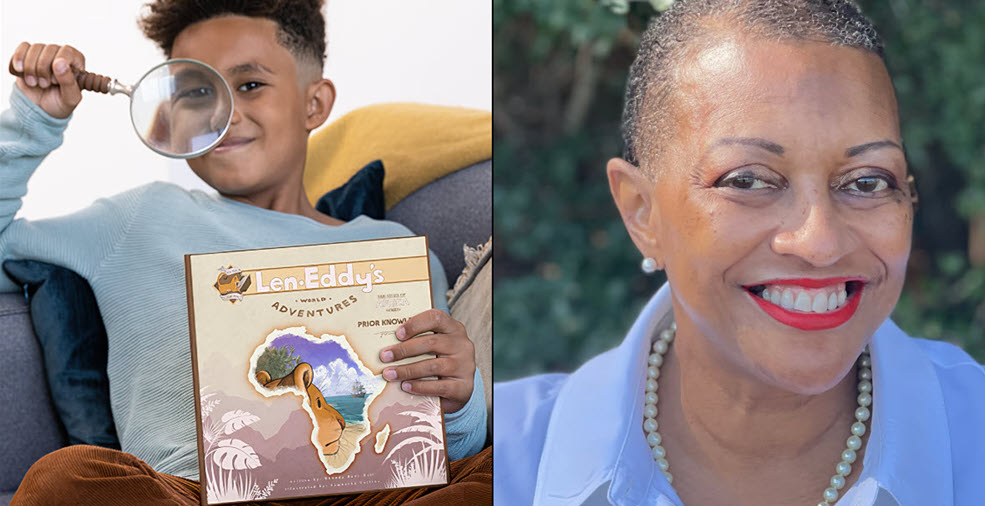Meet Rhonda Bady-Hill: a storyteller, performer, mother, and the creative force behind Len Eddy’s World Adventures, a powerful children’s book series that blends imagination with history, heart with humor, and global awareness with roaring fun. But this is more than just a story about a lion cub who travels the world. It’s a legacy born from love, curiosity, and a deeply personal loss.
Before there was a lion cub exploring the world, there was just one curious boy with a big imagination and a whole lot of questions.
And before there were books—beautiful, vibrant books packed with history, heart, and high-stakes adventures—there was a mother telling bedtime stories in silly voices, hoping to give her kids something better than what the bookstore shelves offered.
Rhonda Bady-Hill didn’t set out to create a book series. She set out to tell the kind of stories kids actually want to hear, and that grownups quietly wish they had growing up.
In this exclusive interview, we sit down with the storyteller behind Len Eddy’s World Adventures to talk about where it all began, what today’s kids really need, and why the world might just be better off with a lion cub leading the way.

How a Roar and a Late-Night Call Inspired a Global Book Series
Q: What was your biggest motivation as a mother when you started inventing stories for your own children? How did that evolve into Len Eddy’s World Adventures?
In the beginning, I told stories such as AESOP’s Fables and fell in love with lions as storytellers. I began to roar like a lion, making good use of my big voice. As a storyteller, I brought stories to life by playing the roles of many characters and using full stages and even different percussion instruments. My work evolved to Len Eddy’s World Adventures once I knew that I wanted to create my own lion stories.
Q: What type of children’s books did you feel were missing, and why?
It wasn’t so much the children’s books that were available at the time that my children were school age, but as a storyteller, I developed a curriculum that resembles The Little Rascals. I offered the curriculum as a workshop for kids ranging from pre-school to the end of grade school. As the facilitator, I noticed that few, if any, participants of any age who signed up to write and tell stories showed a curiosity in history. They were, of course, interested in dinosaurs, but not people. However, as tellers shared their topics of interest before creatively writing the stories, as well as when speaking to teachers, I realized that few students, if any, seemed to be curious about this part of our history, at least in the schools and environments in which I worked at the time.
Q: Let’s start with the heart of it all. Who was the real Len Eddy, and how did he inspire this book series?
Len was a younger cousin who grew up in Chicago. In my early 20s, I moved to Denver, Colorado. One night, during the time of landline telephones, I received a call from Len, whom, by the way, I had only met once or twice, and even at the time, I thought it was brave of him to do so.
After I answered, we politely greeted one another, and he proceeded to inform me that I was a world traveler. I then responded by telling him that I was not. Len insisted, so I asked him why he thought that, and he responded by saying, “You are a world traveler because you live ALL THE WAY in Denver!” There was no moving him from his view, so I recall just going along.
He came across as very serious as he proceeded to ask many questions about my life, my travels, and the world impressively. He asked intelligent questions and spoke with great confidence. Len called me every night, and I looked forward to our chats. However, after about three calls, I requested that I do the calling because his mother was not going to be happy with her phone bill.
I enjoyed his curiosity and his respect. He was by far the most curious kid I had ever met at that point in my life. Because I could not answer many of Lens’ questions off the cuff, I was an avid reader of the USA Today. I suggested that he ask his mom to allow him to pick up the paper so that we could talk about the travel sections from our separate regions. We did, and this is how I learned just how much of the world he wanted and dreamed of seeing. Len wanted to see everything and go everywhere.
I’m not clear about when the conversations ended, but I never forgot them.
Years later, as the young father of two baby daughters, Len was murdered in Chicago, as he headed out on a snowy winter night to pick up a friend and take them to the store, as members of two gangs were at war, as he turned down the street they were on. There were no cell phones, so his friend could not warn him about what was happening.
At the time of Lens’ death and as a mom, I became a storyteller after my son, who was in pre-school, and his teacher wanted me to tell his classmates the funny stories I told him. I later determined that I wanted to write my own stories through the voice of a lion. In my heart, Len was the lion.
Q: Can you describe the moment when the idea of turning Len Eddy’s legacy into a lion cub character first came to you?
Once I began considering ideas for the books, I started exploring the voice and name of the lion. It became clear, as I said before, that I knew it was Len. However, I struggled with naming the lion Len Eddy, because I did not think it had a ring to it. Later, my spirit convinced me to move forward and follow my heart.
Q: What kind of conversations did you and Len have that still echo in these stories today?
Great question, although he was serious, the kid was hilarious. Looking back, he and I were very much alike. I didn’t realize that until this question.
At the time, I was not wise enough to ask him more about his life. I wish I had. Unfortunately, outside of his desire to see the world and learn everything he could about me, my recollection is mostly what I observed about him. But what stands out most is his insistence that I was a world traveller, because, as of about 13 years ago, I have become a world traveller.
And for the first 12 years, I did not put two and two together, meaning the prophetic significance of the child’s words all those years ago.
Q: You’re a voiceover artist, actress, singer, and writer—how have those creative talents shaped the way you tell stories for children?
I brought all of my gifts to every performance. I bring stories to life, using lots of stage or floor space, roaring like a lion, and playing sound instruments, and I do not usually need a microphone. I can tell the same stories over and over, with at least a slight difference every time.
About Len Eddy’s World Adventures
 Q: Your books blend adventure, history, culture, and values in a really unique way. How do you strike that balance without making it feel like a “lesson”?
Q: Your books blend adventure, history, culture, and values in a really unique way. How do you strike that balance without making it feel like a “lesson”?
Separating most of the facts into separate Prior Knowledge books, I hope, will remove the stigma or reality of the seriousness of the lessons and material being taught. While the last four adventure books are created fictionally to make them fun for the reader, the lessons are blended in to distract from the seriousness in hopes that kids will not become bored.
Q: Why did you decide to split each book into two editions—one for younger kids and one for older readers?
I decided to give kids two opportunities: (1) start building their curiosity about history beyond Prehistoric times at a younger age, and (2) if read to them or their siblings, if let’s say they are between the ages of 0-Kindergarten (or whenever they can read the books on their own, they will know the material so well that by middle school, they could teach it to others.
Q: Can you tell us more about the companion book, The Story of Africa? Why was it important to create a ‘prior knowledge’ book before Len’s adventure begins?
It was essential to give a factual view and understanding of age-appropriate facts about the things kids would want to know. These facts can help them better navigate Lens experiences.
The series doesn’t shy away from topics like slavery or injustice, yet it’s crafted to be child-safe and empowering.
Q: How did you approach writing those parts?
The truth matters, and showing the world that this can be done in a non-threatening way is crucial, especially during these times.
Q: What kind of feedback have you received from parents, teachers, or young readers about how these books have impacted them?
Very positive. We conducted two Focus Studies with diverse groups of families and educators, and everyone involved agreed that this is much needed and appropriately done.
Q: Do you write the stories first and then add the historical and geographical research—or the other way around?
No, the other way around.
Q: How do you choose which countries or cultures Len will visit next? Is it based on your own interests, or something deeper?
The Prior Knowledge books are focused on how the world became what it is today, or the origins of civilization. Next, we cover the indigenous people of each continent and what happened to them. We explore the nature, geography, animals, and culture of that time, and evolve each new series to a new continent, until all six, Africa, North America, South America, Asia, Australia, and Europe, are all explained.
Q: Were there any scenes or characters that were especially emotional for you to write?
For this first series, yes. The need to explain enslavement was very emotional at first. I had thoughts like, Am I on the right track, knowing how important it is to do this work? It all came together.
Q: How do you ensure that the stories are respectful and accurate when representing different cultures and peoples?
Actual research.
Q: Do you work closely with your illustrators? How important is the visual element in bringing Len Eddy’s adventures to life?
It’s imperative. And yes, we work very closely. It is so important that I will not use AI-generated illustrations for this legacy project. We will change an illustration as many times as needed to make sure it is right.
Q: Your publishing company, Len Eddy’s Press, launched with a clear mission to change the standard in children’s books. What are the core values behind it?
We want to open up the conversation in homes and schools about human history, cultural differences, and beyond. As parents, we sometimes rely too much on schools and other institutions to teach our children what we think they should know, but if we take a moment to reflect on the time our children were born to pre-school, we taught them everything they knew up to that time. Once they go to school, we should be even more involved with understanding what they are and are not learning, and have a plan as to teaching them what’s (at least in our minds) missing.
Q: There’s such a strong emphasis on empathy, courage, and global awareness. What kind of reader do you hope a Len Eddy story shapes a child into?
I hope to help families build children with roots that include all that is listed. This will ensure that they become good friends and neighbors to others with good character and integrity.
Q: You mentioned plans for translations, audiobooks, and even animation. What’s next for Len Eddy’s World Adventures?
After establishing and completing The Story of Africa series and offering it in other languages, we will begin working on the audiobooks, upload those in different languages, and move to animation.
Q: Why is it so important to you that these stories remain clean, agenda-free, and suitable for all families?
Thank you for asking. The world belongs to all of us. And every child deserves to know the history of those who came before us.
Q: If Len Eddy were alive and sitting here with us today, what do you think he’d say about all this?
He would be over the moon!
Teaching History the Fun Way Kids Actually Enjoy
 If you’re a parent who wants to teach your child about history, cultures, geography, animals, and even tough topics like slavery—but without the heaviness, fear, guilt, shame, or dry textbook feel—Len Eddy’s World Adventures is something special.
If you’re a parent who wants to teach your child about history, cultures, geography, animals, and even tough topics like slavery—but without the heaviness, fear, guilt, shame, or dry textbook feel—Len Eddy’s World Adventures is something special.
Rhonda Bady-Hill has created a unique, groundbreaking series that makes learning feel like magic. These are beautifully written, exciting, action-packed stories that help kids understand the world while also building character by instilling good values and virtues like kindness, courage, honesty, loyalty, and compassion.
They’re clean, thoughtful, and genuinely fun to read. No politics. No agendas. Just meaningful stories that stay with your child long after the book is closed.
LEWA books are the perfect way for parents to teach their kids about the world and history in a super exciting way, without it ever feeling like a lesson. Kids will be begging for the next book!
To explore the books or learn more, visit www.LenEddysPressLLC.com
There, you can dive into the stories, grab your own copies, and follow along as Len Eddy continues his journey around the world.
Let the adventures begin!



